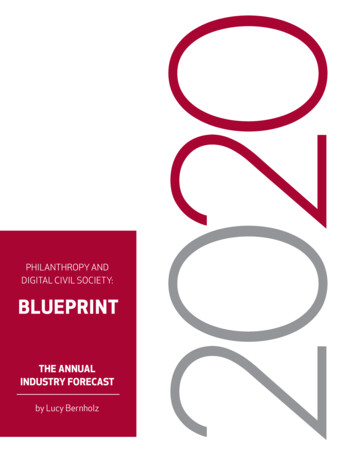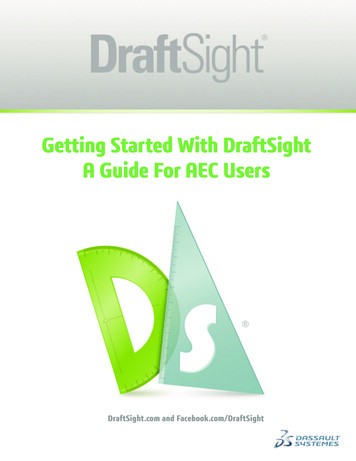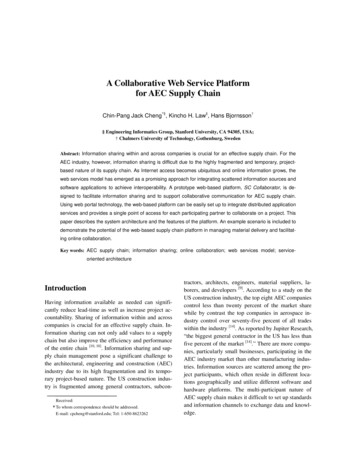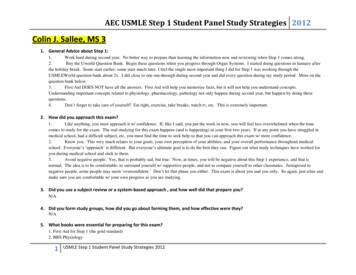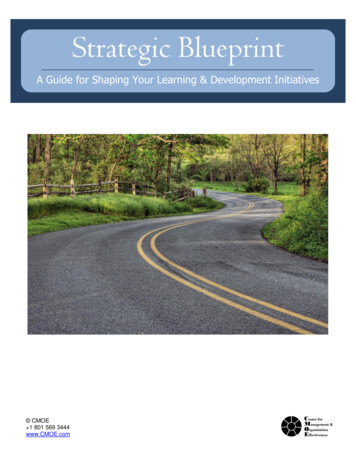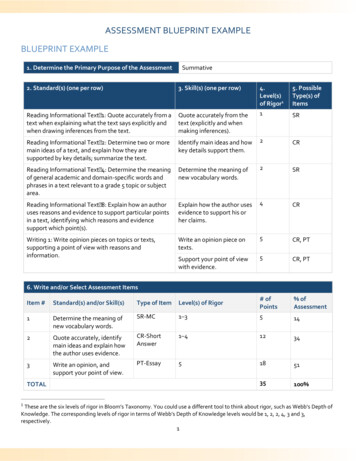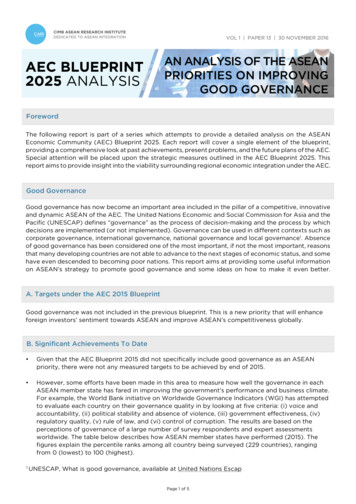
Transcription
VOL 1 PAPER 13 30 NOVEMBER 2016AEC BLUEPRINT2025 ANALYSISAN ANALYSIS OF THE ASEANPRIORITIES ON IMPROVINGGOOD GOVERNANCEForewordThe following report is part of a series which attempts to provide a detailed analysis on the ASEANEconomic Community (AEC) Blueprint 2025. Each report will cover a single element of the blueprint,providing a comprehensive look at past achievements, present problems, and the future plans of the AEC.Special attention will be placed upon the strategic measures outlined in the AEC Blueprint 2025. Thisreport aims to provide insight into the viability surrounding regional economic integration under the AEC.Good GovernanceGood governance has now become an important area included in the pillar of a competitive, innovativeand dynamic ASEAN of the AEC. The United Nations Economic and Social Commission for Asia and thePacific (UNESCAP) defines “governance” as the process of decision-making and the process by whichdecisions are implemented (or not implemented). Governance can be used in different contexts such ascorporate governance, international governance, national governance and local governance1. Absenceof good governance has been considered one of the most important, if not the most important, reasonsthat many developing countries are not able to advance to the next stages of economic status, and somehave even descended to becoming poor nations. This report aims at providing some useful informationon ASEAN’s strategy to promote good governance and some ideas on how to make it even better.A. Targets under the AEC 2015 BlueprintGood governance was not included in the previous blueprint. This is a new priority that will enhanceforeign investors’ sentiment towards ASEAN and improve ASEAN’s competitiveness globally.B. Significant Achievements To Date Given that the AEC Blueprint 2015 did not specifically include good governance as an ASEANpriority, there were not any measured targets to be achieved by end of 2015. However, some efforts have been made in this area to measure how well the governance in eachASEAN member state has fared in improving the government’s performance and business climate.For example, the World Bank initiative on Worldwide Governance Indicators (WGI) has attemptedto evaluate each country on their governance quality in by looking at five criteria: (i) voice andaccountability, (ii) political stability and absence of violence, (iii) government effectiveness, (iv)regulatory quality, (v) rule of law, and (vi) control of corruption. The results are based on theperceptions of governance of a large number of survey respondents and expert assessmentsworldwide. The table below describes how ASEAN member states have performed (2015). Thefigures explain the percentile ranks among all country being surveyed (229 countries), rangingfrom 0 (lowest) to 100 (highest).1UNESCAP, What is good governance, available at United Nations EscapPage 1 of 5
EconomiesVoice andAccountabilityPoliticalStability andAbsence vernmentEffectivenessRegulatoryQualityRule of LawControl 3112.5052.2224.7646.1547.1239.9038.46Lao 6546.1539.41Source: Worldwide Governance Indicators 2015 (World Bank) As the table indicates, Singapore performed well in all aspects except in voice and accountability.Under this dimension Indonesia and the Philippines scored higher, which may indicate that citizensof those two countries have higher degree of freedom of expression and participation in selectingtheir governments. On the other hand, Indonesia and the Philippines did not do well in termsof political stability and domestic security, which may have resulted in relatively more frequentviolence. The governments of Singapore, Brunei Darussalam and Malaysia were the most effectivein formulating and implementing their policies, and in promoting private sector development. Thosethree countries also topped the list in terms of enforcement of rules and regulations to support thedevelopment of the society. Singapore, as expected, has proved to have the cleanest government,meaning that the abuse of power for personal gain is virtually non-existent. The ASEAN Capital Market Forum (ACMF), who is responsible for developing and integrating theequity markets in ASEAN, has been working with the Asian Development Bank (ADB) to producethe ASEAN Corporate Governance (CG) Scorecard for the ASEAN publicly listed companies (PLCs).The objectives of the scorecard and the ranking exercise are to: (i) raise corporate governancestandards and practices of ASEAN PLCs, (ii) showcase and enhance the visibility as well asinvestability of well-governed ASEAN PLCs internationally, and (iii) complement the other ACMFinitiatives and promote ASEAN as an asset class. There are two levels of scoring in the scorecard. The first level is based on the OECD Principles ofCG, which consist of the following five areas: The second level covers (i) bonus itemsreflecting other emerging good practices, and(ii) penalty items reflecting actions and eventswhich are indicative of poor governance. The evaluation is done by the appointeddomestic ranking bodies (DRBs) that conducttheir survey through examination of publiclyavailable information (annual report, websites,etc.) and peer review on PLCs in each ASEANmember state. The scorecard can be appliedas a diagnostic tool by PLCs to identify gapsin their corporate governance practices andassist in achieving sustainable long-termgrowth and value creation2.2AreaWeightIRights of shareholders10%IIEquitable treatment ofshareholders15%IIIRole of stakeholders10%IVDisclosure and transparency25%VResponsibilities of board40%ASEAN Corporate Governance Scorecard, Country Reports andAssessment 2013-2014, ACMF and ADBPage 2 of 5
C. Current Issues and Challenges ASEAN needs to expedite the process of formulating their own criteria for assessing goodgovernance for both public and private sectors so that the relevant stakeholders can identify gapsin their own governance structure. Singapore is a clear example of how high quality governancecan lead to stronger economy and growth.D. Plans under the AEC 2025 Blueprint The AEC Blueprint 2025 states the need to continue to engage various stakeholders to build amore dynamic economic community. The proposed strategic measures include:1. Promoting a more responsive ASEAN by strengthening governance through greatertransparency in the public sector and in engaging with the private sector2. Enhancing engagement with the private sector as well as improving the transparency andsynergies of government policies and business actions across industries and sectors in theASEAN regionE. AEC 2025 Blueprint AnalysisStrategic Measure1 2 Current Status and DevelopmentGreater transparency in the public sectorPromote a more responsive ASEANby strengthening governance throughgreater transparency in the public sectorand in engaging with the private sector With the exception of Singapore, other ASEANmember states still need to significantlyimprove their transparency. Some ASEANcountries are considered among the mostcorrupt countries in the world, but thosecountries have been showing domestic publicsector reforms to fight corruption and theresults should be seen in a few years’ time.Enhanced synergies between government policies and business actionsEnhance engagement with theprivate sector as well as improvingthe transparency and synergies ofgovernment policies and businessactions across industries and sectors inthe ASEAN region The ASEAN Business Advisory Council (BAC)has been advocating for greater involvement ofthe private sector in the decision makings underthe AEC process. However, only in some sectorssuch as insurance, where the insurance regulatorsannually meet with the insurance industry group,have regular consultations really take place. TheASEAN Insurance Forum (AIFo) will be launchedin November 2016 as a platform where therelevant sectoral bodies and the industry groupwill work more closely to develop and integratethe ASEAN insurance sector.Page 3 of 5
F. Conclusion: Moving Forward with the AEC 2025 Plans Good governance is a must if ASEAN wishes to attract larger flow of trade and investment into theregion. The pressure may be larger on the public sector (government) to improve transparencyand fight corruption to show that doing business in the ASEAN region is efficient and profitable.Currently there is a large gap between Singapore, the rest of ASEAN 5 and Vietnam, and newermembers of ASEAN in terms of quality of governance, especially in the public sector. ASEAN needsto develop their set of criteria for corporate governance so that member states can identify theareas they need to improve and address the relevant issues quickly. With regard to creating greater synergy between the government and private sector, the ASEANBAC have had opportunities to meet with the ASEAN Leader during the annual summit, but perhapsmore intensive consultations at the lower levels (Ministers, Senior Officers) would translate moreinto more intensive participation and involvement of the industry in decision makings of sectorsunder the AEC, and therefore, more successful implementation of the strategic measures.Page 4 of 5
ReferencesASEAN Secretariat (2008). ASEAN Economic Community BlueprintASEAN Secretariat (2015). ASEAN 2025: Forging Ahead TogetherASEAN Secretariat (2015). ASEAN Integration Report 2015ASEAN Secretariat (2015). A Blueprint for Growth ASEAN Economic Community 2015: Progress and Key AchievementsASEAN Capital Market Forum (ACMF) and Asian Development Bank (2014). ASEAN Corporate Governance Scorecard 2013-2014.United Nations Economic and Social Commission for Asia and Pacific. What is good governance? (available governance.pdf)Vriens & Partners. Good Governance for International Business 2011Contributing Writer:Dr. Bambang Irawan was formerly an Assistant Director at the ASEAN Secretariat,Jakarta, Indonesia. His portfolio covered cooperation and initiatives under theASEAN finance integration. In his capacity, he coordinated activities and initiativesunder financial services liberalisation, capital account liberalisation, capital marketdevelopment, insurance and taxation.Editor:Jukhee Hong Tunku ‘Abidin MuhrizContact Details:Please contact the CARI for information about this paper: enquiries@cariasean.orgDisclaimer:Any analysis, opinion or editorial contained in this report is based on information sourced from or made available in thepublic domain. CIMB ASEAN Research Institute (CARI) assumes no liability and makes no guarantee, representation orwarranty, whether express or implied, as to the adequacy, accuracy, completeness or reliability of any such informationand analysis, opinion or editorial contained in this report. All readers are advised to conduct their own independentverification and/or evaluation of such information and analysis, opinion or editorial.Page 5 of 5
Economic Community (AEC) Blueprint 2025. Each report will cover a single element of the blueprint, providing a comprehensive look at past achievements, present problems, and the future plans of the AEC. Special attention will be placed upon the strategic measures



